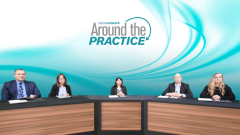
Minimal Residual Disease-Response Adapted Therapy in Transplant-Eligible NDMM
Dr Rebecca Silbermann discusses the results of studies evaluating MRD-response adapted therapy in patients with transplant-eligible NDMM.
Episodes in this series

Surbhi Sidana, MD: We also have dara-KRd, which is a quadruplet regimen of daratumumab, carfilzomib, lenalidomide, and dexamethasone. We had some data presented at ASH [American Society of Hematology Annual Meeting] 2021 from Dr Luciana Costa's MASTER trial, which was an academic consortium trial. It looked at MRD negativity as endpoints to stop therapy or go on.
Dr Silbermann, can you talk about the results of the MASTER trial and how we can incorporate dara-KRd into the clinical landscape, and should patients be getting that regimen over the other quadruplets we have right now.
Rebecca Silbermann, MD: I think it's an important question, but we have to realize that trial was written at a time that we thought dara-KRd would certainly be a better regimen than, say, dara-VRd. MASTER taught us that we could mobilize a group of academic institutions to ask the very interesting and important question of do patients who are considered to be transplant-eligible need to continue on a maintenance regimen forever. What we've learned is that it was possible to do the trial. We learned that dara-KRd is a tolerable regimen, that the toxicity was as expected and was not necessarily worse than the toxicity that we saw for dara-VRd. We began to learn how important it is to follow a minimal residual disease endpoint for these individuals.
Surbhi Sidana, MD: Based on the MRD data, the MRD-SURE data where treatment was discontinued if patients achieved MRD times 2, we saw that some patients were relapsing. Can you talk about the subgroup of patients that were more likely to relapse, and what do we make of that?
Rebecca Silbermann, MD: MASTER's design was adjusted during the course of the trial, and there was an enrichment to include patients with several high-risk cytogenetic abnormalities. In some of the updates that have been provided at conferences, we've seen that there is a difference in how patients do when they have higher risk disease versus patients who have standard risk disease. There were a small number of patients who had relapsed from the MRD-SURE cohorts, but those were generally patients who had very, very high-risk disease. I think this confirmed a lot of the information that we have so far about myeloma risk stratification, at the initiation of therapy.
Surbhi Sidana, MD: So perhaps what this trial shows us is that if you have ultra-high-risk disease, and two or more high-risk abnormalities, perhaps limited duration of therapy is not for those patients. Do you think you'll change your practice based on the results of the trial in standard-risk patients yet?
Rebecca Silbermann, MD: Not quite yet. I think that as a result of this trial, we are certainly looking at MRD more quickly, frequently, and consistently for newly diagnosed patients. It's a challenging conversation with patients, because the data is not yet mature enough to tell them what we're going to start to do if those MRD values should begin to change. But we are certainly considering it early on.
Surbhi Sidana, MD: I think our patients do deserve a treatment-free interval. Hopefully, 1 day, we can get there. And I think this is a great concept to build on for the future.
Newsletter
Stay up to date on recent advances in the multidisciplinary approach to cancer.


















































































